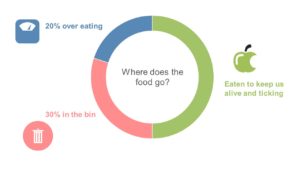Our News
New Year Solutions: Food

We are writing a review of Jo Fidgen’s podcast on BBC 4 of New Year Solutions in which Joe “tackles the ways in which ordinary people can make a difference”. Episode 1 tackles meat and you can listen to it here.
Asparagus from Peru, tomatoes from Spain and lamb from New Zealand – what is in your shopping basket? How did it get there?
In this episode Jo helps us make the right choices in the supermarket, and it’s not as simple as you might think. Seasonal? Transport? Production? Suddenly shopping for your tea has become a mine-field of social-economic-environmental impacts.
Eating Seasonally
Jo chats to Alison Brown (Sustainability Researcher) who admits it is difficult to eat seasonally in the UK. In the depths of winter in Lancashire, a diet of cabbage and potatoes can only be endured for so long. The fact is, most of our food in the UK is imported; we grow only 20% of our fruit and veg.
According to Tim Benton (Professor of Food Systems and Sustainability at Leeds University) in 2015, we imported food from 196 countries. The most was from the Netherlands (£5 billion worth) and the least was from Mongolia (£500 worth). We trade food globally because it makes sense to grow food where the climate and soil are most suitable. Where it is sunny, there is no need for greenhouses, heaters and lighting – some of the biggest culprits of greenhouse gas emissions in agriculture.
Let’s get this straight then, is it better to buy in-season strawberries from Chile than strawberries from a heated and well-lit greenhouse in Kent? From a narrow greenhouse-gas emission perspective – yes, in some cases. But greenhouse gas emissions are only a small piece of a large, and rather complicated, puzzle.
If 80% of emissions are from food production, avoiding imported food is not the best foot forward.
Embedded Water
Have you heard of embedded water? Everything you buy (food and non-food items) requires some water to produce. In the UK we use far more embedded water from abroad than we do from our domestic supply. At home, we use about 140 litres of water per person each day – out of our taps, toilets and showers. To grow the food we eat each day requires:
- about 160 litres of water extracted from rivers and wells per person
- 2 tonnes (2,200 litres) of rain water per person
We import the majority of our fruit and veg from countries where water is already scarce; Spain, Egypt, African countries, and Chile. So what do we do as consumers? How do we factor water usage into our supermarket shop? Tim makes the point that these countries make money by selling us their produce, is it right for us to tell them how to use their water?
I’m beginning to see my quinoa and pomegranate salad in a totally new light, and not a good one. At the very least I will enjoy every last ounce considering the energy and resources it took to make it into my lunchbox. Waste not want not. Right?
Waste Not Want Not
One of the most horrifying statistics from this episode of New Year Solutions is the infamous stat, that 1/3 of food produced in the world is thrown away. On top of that, Tim despairs, we eat on average 20% more than we need to. Are you quickly recalling your knowledge of fractions? Here’s a nifty pie chart.

Have you spotted it yet? We are wasting half of the world’s food supply. While some of us stuff our faces and can afford to be picky, others are forced to live off very limited and often insufficient food.
Leftovers: eat them!
You would be surprised at the bits of vegetables you don’t have to throw away. Cauliflower leaves, celery leaves, pepper tops, spring onions (green and white bits), broccoli stems, carrot tops, pumpkin and butternut squash seeds (roast them), vegetable skins and peelings (delicious vegetable stock), meat carcass (yummy stock), meat fat dripping (amazing oil replacement); all are delicious ingredients!
The freezer is your friend. If you make too much for one meal, pop it into the freezer for later. You can do the same with fruit, veg, bread and pretty much anything. Give it away! Your friends or neighbours will be thankful; I am forever eating for free from my house mates’ leftovers. There are a couple of great apps that support food give-aways. Have a look at OLIO and Too Good to Go.
The ultimate shopping trolley contains local seasonal food, seasonal food from within Europe, un-processed food, foods that don’t require too much water to grow, and not more than you need.
Hmmm. Not as simple as we’d hoped but it is a start.
Happy shopping!